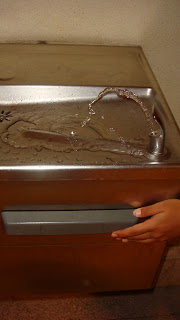

In these two photos, my friend Katie and I are running up a slight incline for a relay in Maui. As you can see, we have both positive displacement and velocity, as displacement is calcuated by finding the shortest path between the initial and final position of an object's motion (and taking into account the direction the object is traveling), and velocity is calculated by dividing the object's displacement by how fast it takes to move to that displacement. Since the displacement was positive, the velocity was also positive. Although our displacement and velocities were both positive, and we're traveling in a forward motion, we actually have negative acceleration, because we're slowing down as we're going forward. Acceleration is the change in instantaneous velocity dividided by elapsed time. Since our velocities in the second picture are lower than our velocities in the first picture, our accelerations are negative. However, if Katie and I happened to have been in better shape for the relay, we would have actually had positive acceleration and ran faster while going up the hill.
Another example of displacement, velocity, and acceleration in these two photos is the car that can be seen in the very back of the first photo and is the second car in the second photo. Its displacement and velocity are both positive, and one can easily see this by looking at its distance relative to the truck that was second to the last in the first photo and first in the second photo. The car also obviously has positive acceleration because of how quickly it moves from its position from way behind in the background of the first picture, to almost right behind the truck in the second picture.
Although Katie and I were slowing down while going up the hill, we must not have been going that slowly because the lady wearing the yellow remains behind us in the second picture. Perhaps she had the exact same negative acceleration!

 Today my dad, my mom, and I carried up our 8-9 foot noble fir chrismtas tree from my garage up the stairs and into my living room. When we got there after much struggling on my dad's part, and relatively little on mine, we had to put the christmas tree into its stand. Our first concern was that the trunk of the huge tree wouldn't fit into the stand, however, that fear was quickly abated when it fit fine, however, soon after we discovered that making the tree stand straight up and keeping it there would be our real problem. After many"1-2-3 lift"s in efforts to screw the tree in straight, we came to the conclusion that the tree was too topheavy to stand on its own. In the second picture you might be able to see how we kept the tree up, by tying a fishing wire from the tree's trunk to a nearby window shutter. That solution worked, as the tree is still standing now. But why did we have to resort to this barbaric form of tree standing? Because the tree's center of mass must have been out of the range of the tree stand's support area. If the tree's CM had been within the support area of the stand we would not have had to use the fishing wire. Now that the tree is up, the next problem is how to decorate that wire to make it less obvious. Any suggestions?
Today my dad, my mom, and I carried up our 8-9 foot noble fir chrismtas tree from my garage up the stairs and into my living room. When we got there after much struggling on my dad's part, and relatively little on mine, we had to put the christmas tree into its stand. Our first concern was that the trunk of the huge tree wouldn't fit into the stand, however, that fear was quickly abated when it fit fine, however, soon after we discovered that making the tree stand straight up and keeping it there would be our real problem. After many"1-2-3 lift"s in efforts to screw the tree in straight, we came to the conclusion that the tree was too topheavy to stand on its own. In the second picture you might be able to see how we kept the tree up, by tying a fishing wire from the tree's trunk to a nearby window shutter. That solution worked, as the tree is still standing now. But why did we have to resort to this barbaric form of tree standing? Because the tree's center of mass must have been out of the range of the tree stand's support area. If the tree's CM had been within the support area of the stand we would not have had to use the fishing wire. Now that the tree is up, the next problem is how to decorate that wire to make it less obvious. Any suggestions?
















